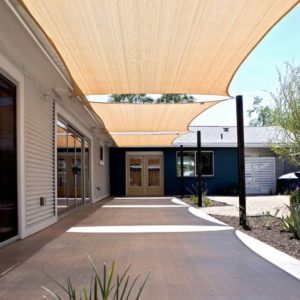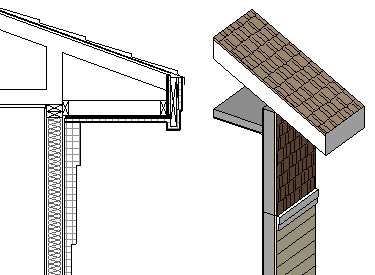Eaves/Shading
Correctly sized Eaves
Eaves are the part of the roof that overhangs the house.
Following the Leaking Building crisis, the importance of correctly designed eaves became apparent, although less is known about the role they play in allowing sun to enter the building during winter and provide free heat, while minimising the potential for overheating in a building in summer. What is the “correct size”?
The correct size of eaves for your home will be influenced primarily by location, as this determines the path of the sun throughout the year.
In summer, the sun follows a “higher” path, while in winter it follows a “lower” path.
More on the sun and how it affects your home can be found here (Passive Solar)
For summer, and particularly for northern climates, you generally want to avoid sunlight entering the home during the summer months and the middle of the day,
as this heat will get soaked up by your building and contribute to overheating.
For winter, and particularly for southern climates, you want to maximise the amount of sunlight that can enter the home, which means having eaves that permit sunlight entering the home when the sun follows a lower path. Generally speaking, a good rule of thumb is having eaves that extend to an angle of 60-80 degrees from the bottom of your glazing to the eave, depending on your location. Software such as SketchUp can use your location to show the sun’s path at different times of the year, and give you an accurate picture of how much sunlight will enter your planned home. Evening sun can also be a problem, but is difficult to be addressed with eave size. See Shading for more information on this topic.
Shading
The single greatest factor in making your home comfortable during summer is managing the amount of sun entering through glazing. 1 square metre of area produces up to 1kW of heating, which is the equivalent of a 6 fin oil column heater, so managing unwanted sun in summer is key to reducing unwanted heating. Evening sun from the west can also be an issue, as the sun becomes lower and shines directly through west facing glazing. Effective shading means preventing unwanted sunlight from entering the home, particularly during summer, when the sun is the fiercest. Shading can be achieved in a number of ways, and is more effective if the sun is prevented from entering the home than once inside (for example by using blinds) Solutions to this problem can include trees, awnings, shutters, glazing, other buildings and screens.


